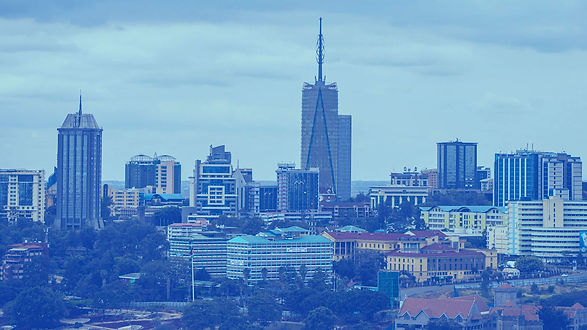

Kenya
Kenya with its population of approximately 50 million people is ranked 7th place on total GDP in Africa. Kenya's median age is approximately 20 years of age.
This reflects a young population, typical of many countries in sub-Saharan Africa, due to high birth rates and improving but still relatively short life expectancies compared to global standards. There is an increasing urbanization trend, with cities like Nairobi and Mombasa experiencing rapid growth.
Kenya spends approximately 5-7% of its GDP on healthcare. Public healthcare expenditure accounts for a significant share but is often supplemented by private spending. Out-of-pocket (OOP) expenses make up a substantial portion of healthcare financing, contributing to financial hardship for many Kenyan households. There is also a National Health Insurance Fund (NHIF), which is a mandatory health insurance scheme for formal sector employees, with voluntary enrollment for informal workers. It aims to provide universal health coverage (UHC).
Kenya's Healthcare System
The structure of the healthcare system can be divided in three groups:
-
Public Sector: Managed by the Ministry of Health (MOH) and county governments. This includes public hospitals, health centres, and dispensaries.
-
Private Sector: Comprises private hospitals, clinics, and pharmacies catering to higher-income groups.
-
Faith-Based and NGO Sector: Provides affordable care, especially in underserved rural areas.
There can be 6 levels of care distinguished in Kenya:
-
Level 1: Community Health Services (care provided through community health volunteers).
-
Level 2: Dispensaries and clinics (basic outpatient services).
-
Level 3: Health centers (comprehensive outpatient care and some inpatient services).
-
Level 4: County hospitals (general inpatient and outpatient care).
-
Level 5: Referral and regional hospitals (specialized care and training centers).
-
Level 6: National referral hospitals (highly specialized care, e.g., Kenyatta National Hospital (https://knh.or.ke), Moi Teaching and Referral Hospital (https://www.mtrh.go.ke).

Key health issues
Like in many other African countries, communicable, non-communicable diseases and issues around maternal and child health are quite common:
-
Communicable, infectious diseases: HIV/AIDS, malaria, and tuberculosis remain major public health issues.
-
Non-Communicable Diseases (NCDs): Rising burden of diabetes, hypertension, and cancer due to lifestyle changes.
-
Maternal and Child Health: Relatively high maternal and infant mortality rates, though improving.
Medical device and IVD registration
The Pharmacy and Poisons Board (PPB, https://web.pharmacyboardkenya.org/) is the National Regulatory Authority established under the Pharmacy and Poisons Act, Cap 244 of the Laws of Kenya, to regulate the profession of pharmacy and ensure the safety, quality and efficacy/effectiveness of health products and health technologies including medical devices and in Vitro diagnostics before letting into the Kenyan market.
Classification of Medical Devices and IVDs
Devices are classified into four classes (A, B, C, D) based on risk levels:
-
Class A: Low risk (e.g., bandages)
-
Class B: Low-to-moderate risk (e.g., Urinary catheters, removable dental prosthesis))
-
Class C: Moderate-to-high risk (e.g., catheters containing sealed radioisotopes, Urethral stents, contact lenses for Lon-term continuous use)
-
Class D: High risk (e.g., pacemakers, IVDs for blood-bone pathogens, deep brain stimulation electrodes).
Requirements for Registration
Requirements for Registration of medical devices and IVDs in Kenya are summarized under what’s called a CSDT: the Common Submission Dossier Template which serves to clarify the information to be submitted in each section of this document and the format that this information is to be submitted in.
Requirements of Registration as well as the pathway through the registration process within PPB the local Authority of Regulation system depend on the class of the medical device subject to be registered.
The level of regulatory requirements increases as the level of the device risk class increases. These regulatory controls may include, and not limited to:
- Operation of Quality System (recommended for all devices)
- Submission of technical data;
- Product testing using in-house or independent resources;
- Documentation of clinical evidence to support the manufacturer’s claims;
- The need for and frequency of independent external audit of the manufacturer’s quality system;
- Independent external review of the manufacturer’s technical data.
etc
Submission, validity and post approval obligations
Application Process which is to be followed for all medical devices and IVDs is as follow:
Step 1: Submission of Application to the online portal;
Step 2: Verification of submitted Application;
Step 3: Reviewing of the Application;
Step 4: Regulatory outcome and issuance of Registration Certificate
Registration fees are non-refundable and are to be paid at the moment of submission of the application.
Registration fees are related to the class of the medical device.
The Registration Certificate is valid for 5 years.
The registration process typically takes up to 12 months.
Post-Approval Obligations typically must deal with:
-
Labelling (ensuring labels meet PPB requirements, including product name, batch/lot number, expiry date, and instructions)
-
Adverse Event Reporting (reporting any device-related adverse events or malfunctions to PPB)
-
Product Safety Vigilance reporting;
-
Field Safety Corrective Action implementation, management, coordination and reporting.
-
Renewal (submission of renewal applications at least six months before expiration).
-
Change/Variations Notifications;
-
Annual Retention requirements.

